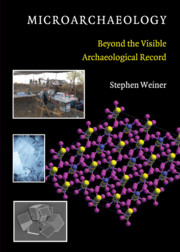Book contents
- Frontmatter
- Contents
- Preface
- 1 Archaeology, Archaeological Science, and Microarchaeology
- 2 Information Embedded in the Microscopic Record
- 3 Completeness of the Archaeological Record
- 4 Common Mineral Components of the Archaeological Record
- 5 Biological Materials: Bones and Teeth
- 6 Biological Materials: Phytoliths, Diatoms, Eggshells, Otoliths, and Mollusk Shells
- 7 Reconstructing Pyrotechnological Processes
- 8 Biological Molecules and Macromolecules: Protected Niches
- 9 Ethnoarchaeology of the Microscopic Record: Learning from the Present
- 10 Absolute Dating: Assessing the Quality of a Date
- 11 Reading the Microscopic Record On-Site
- 12 Infrared Spectroscopy in Archaeology
- Appendix A Identifying Minerals Using Microchemical Analysis
- Appendix B Identifying Minerals and Compounds Using Infrared Spectra: Table of Standard Minerals and Compounds for Which Infrared Spectra Are Available
- References
- Index
- Plates section
6 - Biological Materials: Phytoliths, Diatoms, Eggshells, Otoliths, and Mollusk Shells
Published online by Cambridge University Press: 05 June 2012
- Frontmatter
- Contents
- Preface
- 1 Archaeology, Archaeological Science, and Microarchaeology
- 2 Information Embedded in the Microscopic Record
- 3 Completeness of the Archaeological Record
- 4 Common Mineral Components of the Archaeological Record
- 5 Biological Materials: Bones and Teeth
- 6 Biological Materials: Phytoliths, Diatoms, Eggshells, Otoliths, and Mollusk Shells
- 7 Reconstructing Pyrotechnological Processes
- 8 Biological Molecules and Macromolecules: Protected Niches
- 9 Ethnoarchaeology of the Microscopic Record: Learning from the Present
- 10 Absolute Dating: Assessing the Quality of a Date
- 11 Reading the Microscopic Record On-Site
- 12 Infrared Spectroscopy in Archaeology
- Appendix A Identifying Minerals Using Microchemical Analysis
- Appendix B Identifying Minerals and Compounds Using Infrared Spectra: Table of Standard Minerals and Compounds for Which Infrared Spectra Are Available
- References
- Index
- Plates section
Summary
Mineralized biological materials in an archaeological site can potentially provide much information on past human behavior. Many of the organisms that produced the mineralized materials were brought to the site by humans or their domesticated animals, and the mineralized material itself often has embedded information about the past environment around or within the site. Bones and teeth are the “traditional fare” of archaeological studies involving biological materials (Chapter 5). Eggshells, mollusk shells, fish otoliths, diatoms, and plant phytoliths are other biological materials often found in archaeological sites that can also contribute in many ways to the reconstruction of past human behavior. Phytoliths, in particular, are often abundant in archaeological sites and provide information about a key component of human life that is usually not visible to the naked eye, namely, the archaeobotanical record.
This chapter is a continuation of Chapter 5. Here phytoliths, diatoms, eggshells, fish otoliths, and mollusk shells are discussed. Each section ends with a list of the embedded information that can, under certain circumstances, be extracted from these materials.
PHYTOLITHS
Plants produce a variety of different minerals, including two forms of calcium oxalate, silica, calcite, aragonite, vaterite, amorphous calcium carbonate, and various organic crystals (Lowenstam and Weiner, 1989). The term phytolith strictly refers to all the minerals that plants produce. In archaeology, the term phytolith has, for the most part, become synonymous with one category of minerals produced by plants, namely, those composed of the mineral silica (also known as opal; Piperno, 2006).
- Type
- Chapter
- Information
- MicroarchaeologyBeyond the Visible Archaeological Record, pp. 135 - 164Publisher: Cambridge University PressPrint publication year: 2010



